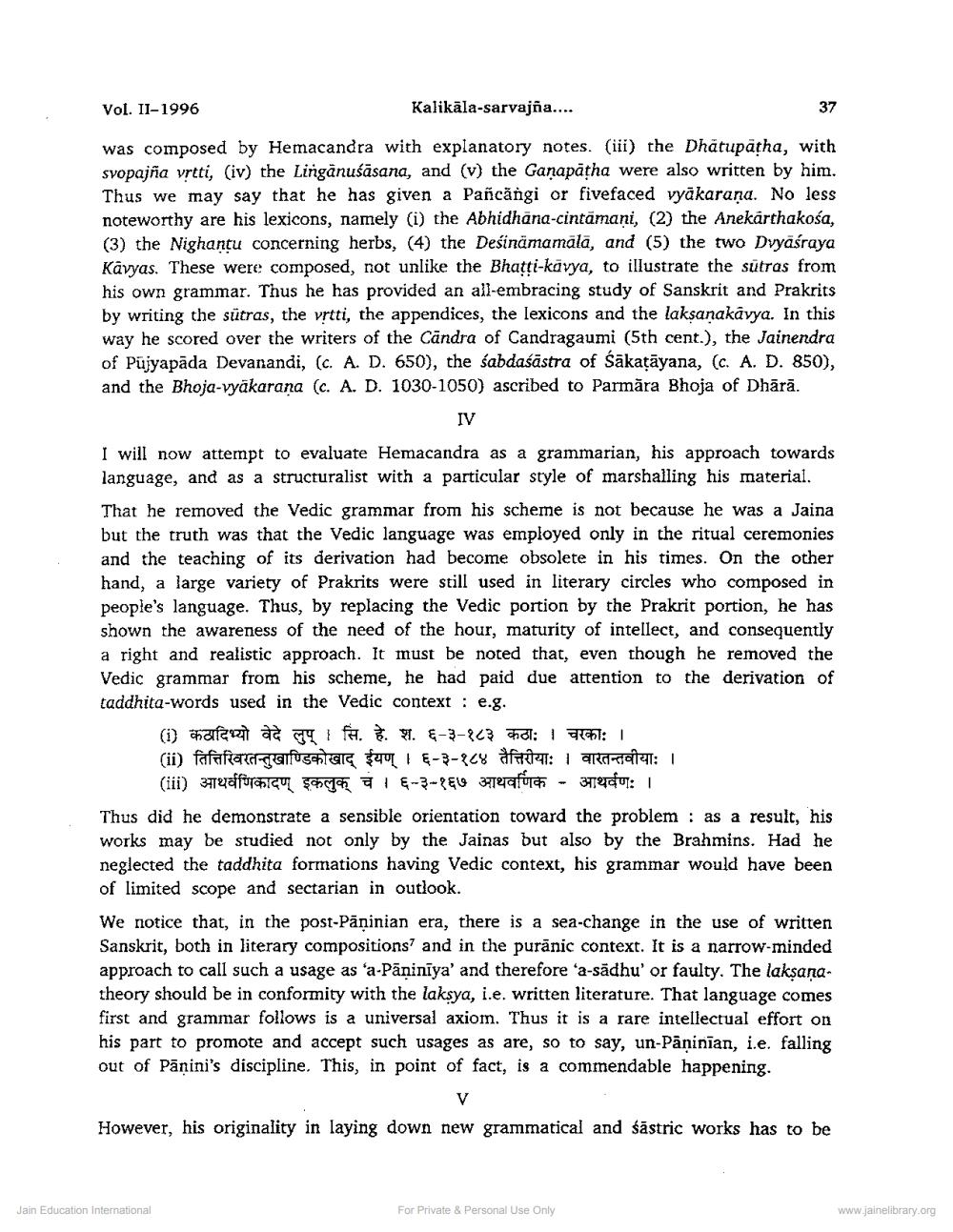________________
Vol. II-1996
Kalikāla-sarvajña....
was composed by Hemacandra with explanatory notes. (iii) the Dhätupatha, with svopajña vrtti, (iv) the Linganuśāsana, and (v) the Ganapātha were also written by him. Thus we may say that he has given a Pancangi or fivefaced vyäkarana. No less noteworthy are his lexicons, namely (i) the Abhidhana-cintamani, (2) the Anekarthakośa, (3) the Nighantu concerning herbs, (4) the Desinämamalā, and (5) the two Dvyasraya Kavyas. These were composed, not unlike the Bhatti-kavya, to illustrate the sutras from his own grammar. Thus he has provided an all-embracing study of Sanskrit and Prakrits by writing the sütras, the vrtti, the appendices, the lexicons and the laksanakavya. In this way he scored over the writers of the Cāndra of Candragaumi (5th cent.), the Jainendra of Pujyapāda Devanandi, (C. A. D. 650), the sabdaśāstra of Sākatāyana, (c. A. D. 850), and the Bhoja-vyäkarana (c. A. D. 1030-1050) ascribed to Parmāra Bhoja of Dhārā.
IV
I will now attempt to evaluate Hemacandra as a grammarian, his approach towards language, and as a structuralist with a particular style of marshalling his material. That he removed the Vedic grammar from his scheme is not because he was a Jaina but the truth was that the Vedic language was employed only in the ritual ceremonies and the teaching of its derivation had become obsolete in his times. On the other hand, a large variety of Prakrits were still used in literary circles who composed in people's language. Thus, by replacing the Vedic portion by the Prakrit portion, he has shown the awareness of the need of the hour, maturity of intellect, and consequently a right and realistic approach. It must be noted that, even though he removed the Vedic grammar from his scheme, he had paid due attention to the derivation of taddhita-words used in the Vedic context : e.g.
(i) walezi ad H . 9. E-3-823 chol: 1 ash: (ii) faferflocagarfuSnaig $4901 E-3-828 ofer: 1 araweiten: 1
(iii) 374df High Schoo l E-3-869 3erfuch - 3400: Thus did he demonstrate a sensible orientation toward the problem : as a result, his works may be studied not only by the Jainas but also by the Brahmins. Had he neglected the taddhita formations having Vedic context, his grammar would have been of limited scope and sectarian in outlook. We notice that, in the post-Pāņinian era, there is a sea-change in the use of written Sanskrit, both in literary compositions and in the purānic context. It is a narrow-minded approach to call such a usage as 'a-Paninīya' and therefore 'a-sādhu' or faulty. The laksanatheory should be in conformity with the laksya, i.e. written literature. That language comes first and grammar follows is a universal axiom. Thus it is a rare intellectual effort on his part to promote and accept such usages as are, so to say, un-Pāṇinian, i.e. falling out of Panini's discipline. This, in point of fact, is a commendable happening.
However, his originality in laying down new grammatical and śāstric works has to be
Jain Education International
For Private & Personal Use Only
www.jainelibrary.org




